2006 SUBARU IMPREZA tire size
[x] Cancel search: tire sizePage 257 of 365
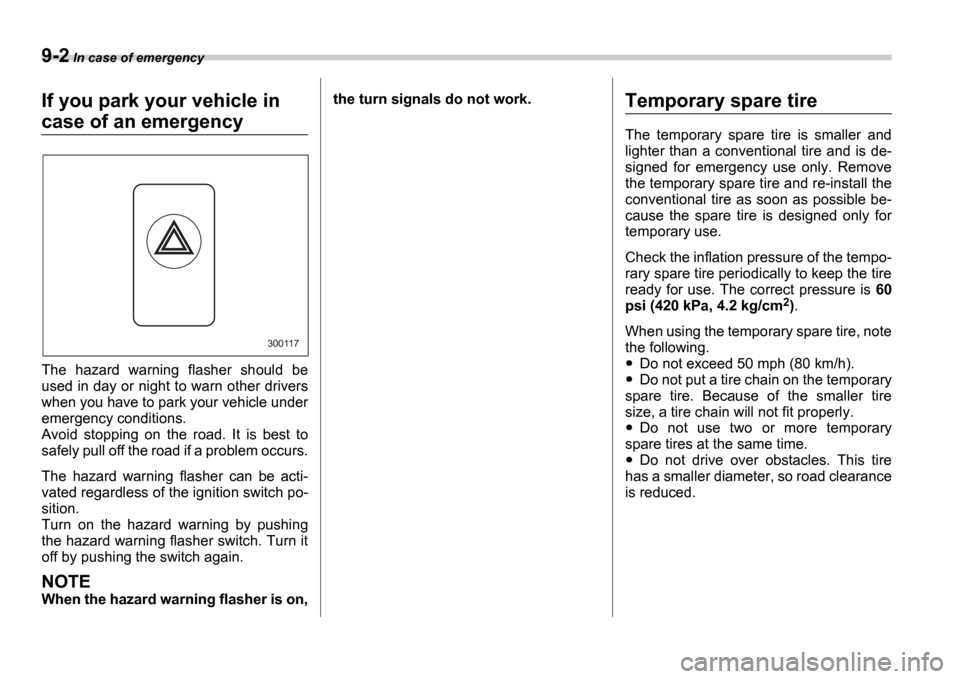
9-2 In case of emergency
In case of emergencyIf you park your vehicle in
case of an emergency
The hazard warning flasher should be
used in day or night to warn other drivers
when you have to park your vehicle under
emergency conditions.
Avoid stopping on the road. It is best to
safely pull off the road if a problem occurs.
The hazard warning flasher can be acti-
vated regardless of the ignition switch po-
sition.
Turn on the hazard warning by pushing
the hazard warning flasher switch. Turn it
off by pushing the switch again.
NOTE
When the hazard warning flasher is on, the turn signals do not work.
Temporary spare tire
The temporary spare tire is smaller and
lighter than a conventional tire and is de-
signed for emergency use only. Remove
the temporary spare tire and re-install the
conventional tire as soon as possible be-
cause the spare tire is designed only for
temporary use.
Check the inflation pressure of the tempo-
rary spare tire periodically to keep the tire
ready for use. The correct pressure is
60
psi (420 kPa, 4.2 kg/cm
2) .
When using the temporary spare tire, note
the following.
Do not exceed 50 mph (80 km/h).
Do not put a tire chain on the temporary
spare tire. Because of the smaller tire
size, a tire chain will not fit properly.
Do not use two or more temporary
spare tires at the same time.
Do not drive over obstacles. This tire
has a smaller diameter, so road clearance
is reduced.
300117
Page 258 of 365

In case of emergency 9-3
1) Tread wear indicator bar
2) Indicator location mark
When the wear indicator appears on the
tread, replace the tire.
The temporary spare tire must be used
only on a rear wheel. If a front wheel tire
gets punctured, replace the wheel with a
rear wheel and install the temporary spare
tire in place of the removed rear wheel.
1) Spare fuse
2) FWD connector
NOTE
(If your vehicle is AWD with automatic
transmission, except Turbo models)
Before driving your vehicle with the
temporary spare tire, put a spare fuse
inside the FWD connector in the main
fuse box located in the engine com-
partment and confirm that the Front-
wheel drive warning light AWD in the
combination meter comes on. The All-
Wheel Drive capability of the vehicle
has now deactivated. After re-installing
the conventional tire, remove the spare
fuse from the FWD connector in order
to reactivate All-Wheel Drive.
900231
1
22 1
900266
Never tow a trailer when the tempo-
rary spare tire is used. The tempo-
rary spare tire is not designed to
sustain the towing load. Use of the
temporary spare tire when towing
can result in failure of the spare tire
and/or less stability of the vehicle
and may lead to an accident.
Never use any temporary spare tire
other than the original. Using other
sizes may result in severe mechani-
cal damage to the drive train of your
vehicle.
Page 312 of 365
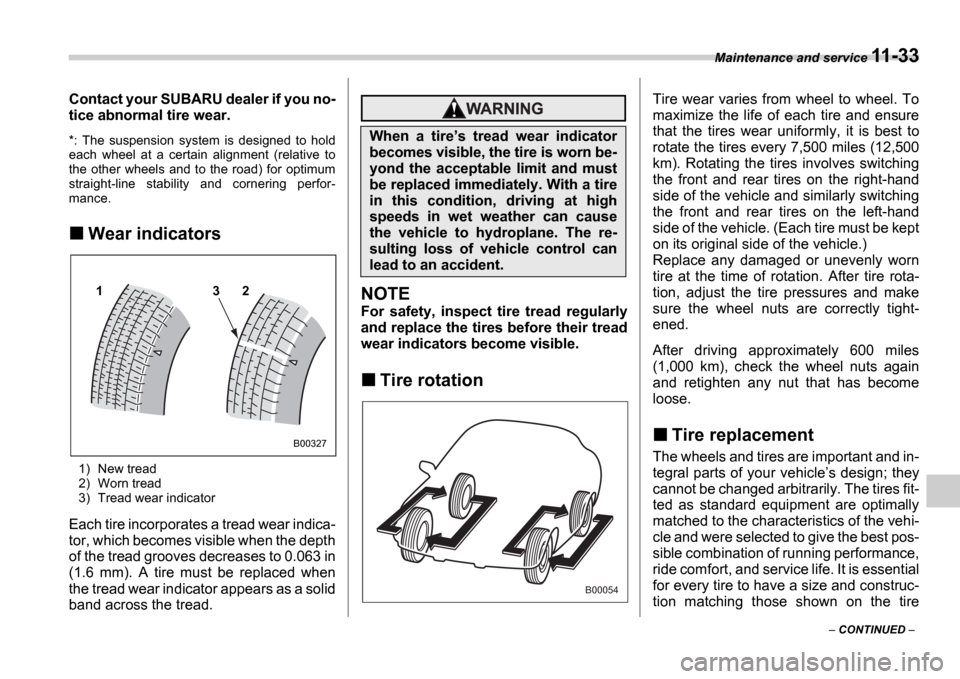
Maintenance and service 11-33
CONTINUED
Contact your SUBARU dealer if you no-
tice abnormal tire wear.
*: The suspension system is designed to hold
each wheel at a certain alignment (relative to
the other wheels and to the road) for optimum
straight-line stability and cornering perfor-
mance.
Wear indicators
1) New tread
2) Worn tread
3) Tread wear indicator
Each tire incorporates a tread wear indica-
tor, which becomes visible when the depth
of the tread grooves decreases to 0.063 in
(1.6 mm). A tire must be replaced when
the tread wear indicator appears as a solid
band across the tread.
NOTE
For safety, inspect tire tread regularly
and replace the tires before their tread
wear indicators become visible.
Tire rotation
Tire wear varies from wheel to wheel. To
maximize the life of each tire and ensure
that the tires wear uniformly, it is best to
rotate the tires every 7,500 miles (12,500
km). Rotating the tires involves switching
the front and rear tires on the right-hand
side of the vehicle and similarly switching
the front and rear tires on the left-hand
side of the vehicle. (Each tire must be kept
on its original side of the vehicle.)
Replace any damaged or unevenly worn
tire at the time of rotation. After tire rota-
tion, adjust the tire pressures and make
sure the wheel nuts are correctly tight-
ened.
After driving approximately 600 miles
(1,000 km), check the wheel nuts again
and retighten any nut that has become
loose.
Tire replacement
The wheels and tires are important and in-
tegral parts of your vehicle s design; they
cannot be changed arbitrarily. The tires fit-
ted as standard equipment are optimally
matched to the characteristics of the vehi-
cle and were selected to give the best pos-
sible combination of running performance,
ride comfort, and service life. It is essential
for every tire to have a size and construc-
tion matching those shown on the tire
1 2 3
B00327
When a tires tread wear indicator
becomes visible, the tire is worn be-
yond the acceptable limit and must
be replaced immediately. With a tire
in this condition, driving at high
speeds in wet weather can cause
the vehicle to hydroplane. The re-
sulting loss of vehicle control can
lead to an accident.
B00054
Page 313 of 365

11-34 Maintenance and service
placard and to have a speed symbol and
load index matching those shown on the
tire placard.
Using tires of a non-specified size detracts
from controllability, ride comfort, braking
performance, speedometer accuracy and
odometer accuracy. It also creates incor-
rect body-to-tire clearances and inappro-
priately changes the vehicle s ground
clearance.
All four tires must be the same in terms of
manufacturer, brand (tread pattern), con-
struction, and size. You are advised to re-
place the tires with new ones that are
identical to those fitted as standard equip-
ment.
For safe vehicle operation, SUBARU rec-
ommends replacing all four tires at the
same time.
Wheel replacement
When replacing wheels due, for example,
to damage, make sure the replacement
wheels match the specifications of the
wheels that are fitted as standard equip-
ment. Replacement wheels are available
from SUBARU dealers.
NOTE
When any of the wheels is removed
and replaced for tire rotation or to
change a flat tire, always check the
tightness of the wheel nuts after driv-
ing approximately 600 miles (1,000
km). If any nut is loose, tighten it to the
specified torque.
All four tires must be the same in
terms of manufacturer, brand
(tread pattern), construction, de-
gree of wear, speed symbol, load
index and size. Mixing tires of dif-
ferent types, sizes or degrees of
wear can result in damage to vehi-
cle s power train. Use of different
types or sizes of tires can also
dangerously reduce controllabili-
ty and braking performance and
can lead to an accident.
Use only radial tires. Do not use
radial tires together with belted
bias tires and/or bias-ply tires. Do-
ing so can dangerously reduce
controllability, resulting in an ac-
cident.
Use only those wheels that are
specified for your vehicle. Wheels
not meeting specifications could in-
terfere with brake caliper operation
and may cause the tires to rub
against the wheel well housing dur-
ing turns. The resulting loss of vehi-
cle control could lead to an acci-
dent.
Page 335 of 365
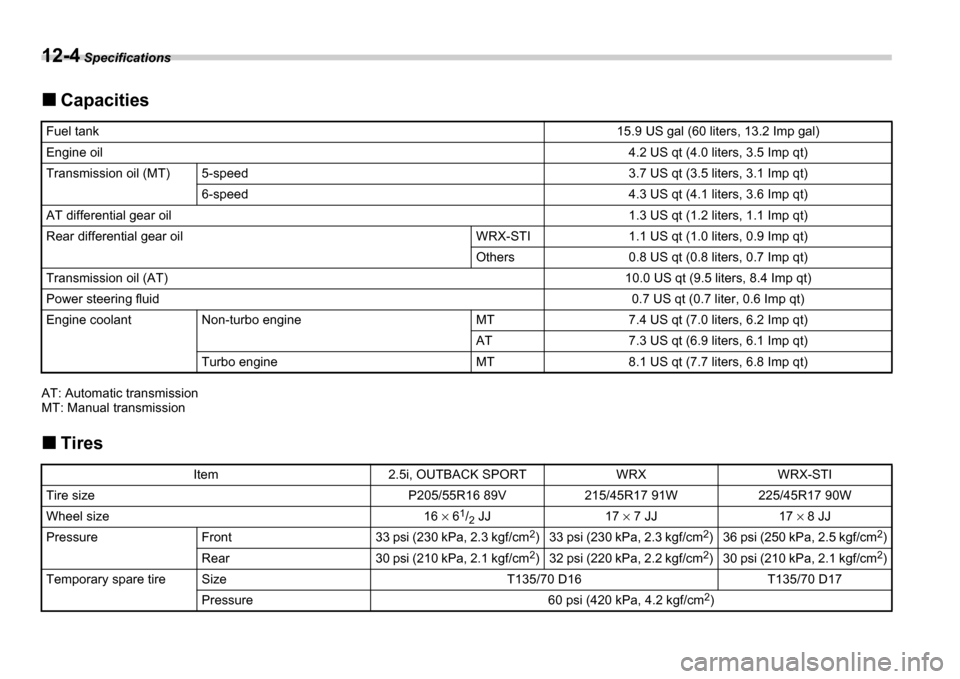
12-4 Specifications
Capacities
AT: Automatic transmission
MT: Manual transmission
Tires
Fuel tank15.9 US gal (60 liters, 13.2 Imp gal)
Engine oil4.2 US qt (4.0 liters, 3.5 Imp qt)
Transmission oil (MT)5-speed3.7 US qt (3.5 liters, 3.1 Imp qt)
6-speed4.3 US qt (4.1 liters, 3.6 Imp qt)
AT differential gear oil1.3 US qt (1.2 liters, 1.1 Imp qt)
Rear differential gear oilWRX-STI1.1 US qt (1.0 liters, 0.9 Imp qt)
Others0.8 US qt (0.8 liters, 0.7 Imp qt)
Transmission oil (AT)10.0 US qt (9.5 liters, 8.4 Imp qt)
Power steering fluid0.7 US qt (0.7 liter, 0.6 Imp qt)
Engine coolantNon-turbo engineMT7.4 US qt (7.0 liters, 6.2 Imp qt)
AT7.3 US qt (6.9 liters, 6.1 Imp qt)
Turbo engineMT8.1 US qt (7.7 liters, 6.8 Imp qt)
Item2.5i, OUTBACK SPORTWRXWRX-STI
Tire sizeP205/55R16 89V215/45R17 91W225/45R17 90W
Wheel size16 6 1
/2 JJ17
7 JJ17 8 JJ
PressureFront33 psi (230 kPa, 2.3 kgf/cm 2
)33 psi (230 kPa, 2.3 kgf/cm 2
)36 psi (250 kPa, 2.5 kgf/cm 2
)
Rear30 psi (210 kPa, 2.1 kgf/cm 2
)32 psi (220 kPa, 2.2 kgf/cm 2
)30 psi (210 kPa, 2.1 kgf/cm 2
)
Temporary spare tireSizeT135/70 D16T135/70 D17
Pressure60 psi (420 kPa, 4.2 kgf/cm 2
)
Page 343 of 365
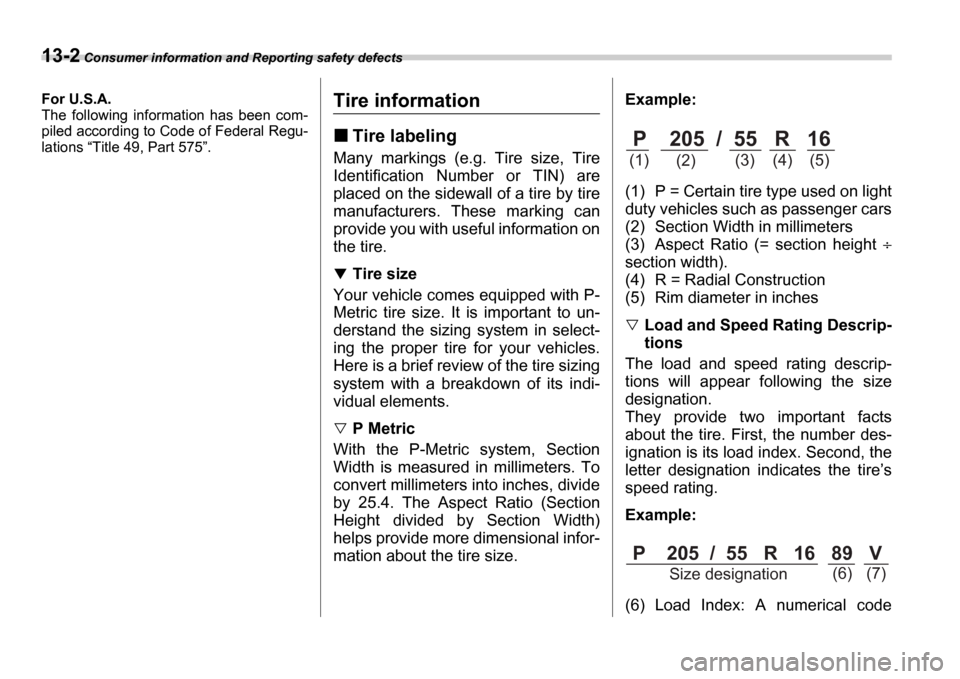
13-2 Consumer information and Reporting safety defects
Consumer information and Reporting safety defectsFor U.S.A.
The following information has been com-
piled according to Code of Federal Regu-
lations Title 49, Part 575 .Tire information
Tire labeling
Many markings (e.g. Tire size, Tire
Identification Number or TIN) are
placed on the sidewall of a tire by tire
manufacturers. These marking can
provide you with useful information on
the tire.
Tire size
Your vehicle comes equipped with P-
Metric tire size. It is important to un-
derstand the sizing system in select-
ing the proper tire for your vehicles.
Here is a brief review of the tire sizing
system with a breakdown of its indi-
vidual elements.
P Metric
With the P-Metric system, Section
Width is measured in millimeters. To
convert millimeters into inches, divide
by 25.4. The Aspect Ratio (Section
Height divided by Section Width)
helps provide more dimensional infor-
mation about the tire size. Example:
(1) P = Certain tire type used on light
duty vehicles such as passenger cars
(2) Section Width in millimeters
(3) Aspect Ratio (= section height
section width).
(4) R = Radial Construction
(5) Rim diameter in inches
Load and Speed Rating Descrip-
tions
The load and speed rating descrip-
tions will appear following the size
designation.
They provide two important facts
about the tire. First, the number des-
ignation is its load index. Second, the
letter designation indicates the tire s
speed rating.
Example:
(6) Load Index: A numerical code
P 205 / 55 R 16
(1) (2) (3) (4) (5)
P 205 / 55 R 16 89 V
Size designation (6) (7)
Page 344 of 365
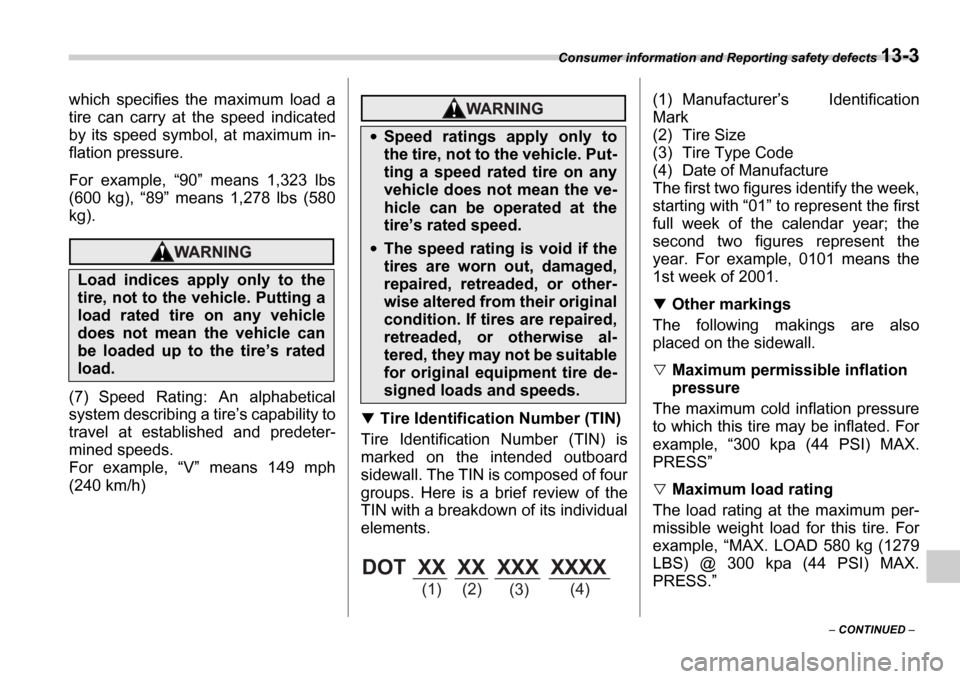
Consumer information and Reporting safety defects 13-3
CONTINUED
which specifies the maximum load a
tire can carry at the speed indicated
by its speed symbol, at maximum in-
flation pressure.
For example,
90 means 1,323 lbs
(600 kg), 89 means 1,278 lbs (580
kg).
(7) Speed Rating: An alphabetical
system describing a tire s capability to
travel at established and predeter-
mined speeds.
For example, V means 149 mph
(240 km/h)
Tire Identification Number (TIN)
Tire Identification Number (TIN) is
marked on the intended outboard
sidewall. The TIN is composed of four
groups. Here is a brief review of the
TIN with a breakdown of its individual
elements. (1) Manufacturer
s Identification
Mark
(2) Tire Size
(3) Tire Type Code
(4) Date of Manufacture
The first two figures identify the week,
starting with 01 to represent the first
full week of the calendar year; the
second two figures represent the
year. For example, 0101 means the
1st week of 2001.
Other markings
The following makings are also
placed on the sidewall.
Maximum permissible inflation
pressure
The maximum cold inflation pressure
to which this tire may be inflated. For
example, 300 kpa (44 PSI) MAX.
PRESS
Maximum load rating
The load rating at the maximum per-
missible weight load for this tire. For
example, MAX. LOAD 580 kg (1279
LBS) @ 300 kpa (44 PSI) MAX.
PRESS.
Load indices apply only to the
tire, not to the vehicle. Putting a
load rated tire on any vehicle
does not mean the vehicle can
be loaded up to the tire s rated
load.
Speed ratings apply only to
the tire, not to the vehicle. Put-
ting a speed rated tire on any
vehicle does not mean the ve-
hicle can be operated at the
tire s rated speed.
The speed rating is void if the
tires are worn out, damaged,
repaired, retreaded, or other-
wise altered from their original
condition. If tires are repaired,
retreaded, or otherwise al-
tered, they may not be suitable
for original equipment tire de-
signed loads and speeds.
DOT XX XX XXX XXXX
(1) (2) (3)(4)
Page 346 of 365
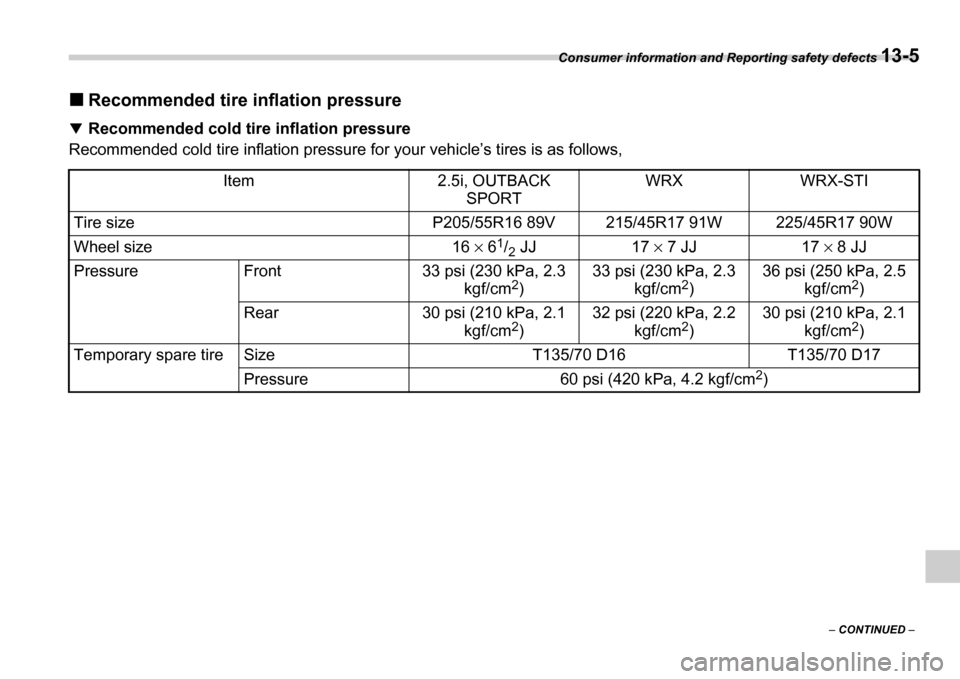
Consumer information and Reporting safety defects 13-5
CONTINUED
Recommended tire inflation pressure
Recommended cold tire inflation pressure
Recommended cold tire inflation pressure for your vehicle s tires is as follows,
Item2.5i, OUTBACK
SPORTWRXWRX-STI
Tire sizeP205/55R16 89V215/45R17 91W225/45R17 90W
Wheel size16 61/2 JJ17 7 JJ17 8 JJ
PressureFront33 psi (230 kPa, 2.3 kgf/cm2)
33 psi (230 kPa, 2.3 kgf/cm2)
36 psi (250 kPa, 2.5 kgf/cm2)
Rear30 psi (210 kPa, 2.1
kgf/cm2)
32 psi (220 kPa, 2.2 kgf/cm2)
30 psi (210 kPa, 2.1 kgf/cm2)
Temporary spare tireSizeT135/70 D16T135/70 D17
Pressure60 psi (420 kPa, 4.2 kgf/cm2)